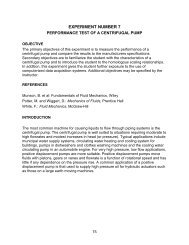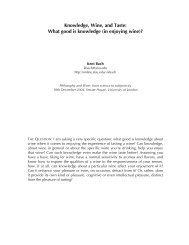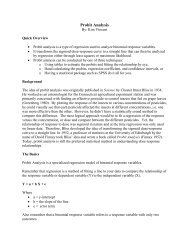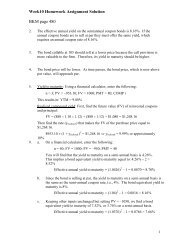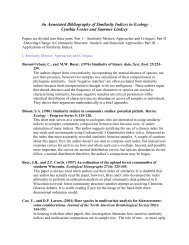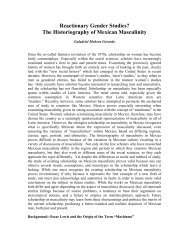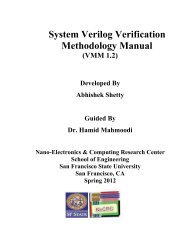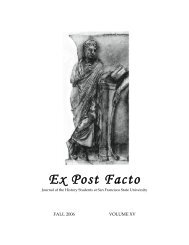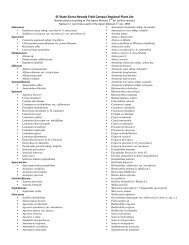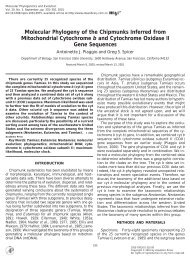Biol 529 Plant Ecology Similarity among communities Communities ...
Biol 529 Plant Ecology Similarity among communities Communities ...
Biol 529 Plant Ecology Similarity among communities Communities ...
You also want an ePaper? Increase the reach of your titles
YUMPU automatically turns print PDFs into web optimized ePapers that Google loves.
<strong>Biol</strong> <strong>529</strong> <strong>Plant</strong> <strong>Ecology</strong> <br />
<strong>Similarity</strong> <strong>among</strong> <strong>communities</strong> <br />
<strong>Communities</strong> can differ in a number of ways. Considering only the plant component of a system, two <br />
<strong>communities</strong> can differ in species composition (taxonomy), total number of species (richness), and the <br />
relative abundance of species (evenness). Species diversity refers to a community-‐level concept that <br />
combines both richness and evenness. <br />
We use a number of different indices to estimate the similarity of two <strong>communities</strong>. Considerable <br />
controversy exists about the effectiveness of these indices as they vary in performance for things like total <br />
number of species involved, influence of rare species, etc. A number of papers recently have explored what <br />
an appropriate index might be. <br />
We will use a few of the common ones that you will frequently come across in the literature so you can get an <br />
impression of their usefulness. They fall into two categories, presence-‐absence measures, which focus on <br />
richness and composition, and abundance measures, with incorporate richness, composition, and abundance. <br />
We will use the following indices: <br />
Jaccard (presence-‐absence) <br />
S J = <br />
a/a+b+c <br />
Sorensen-Dice (Sorensen or Sorensen binary) (presence-‐absence) <br />
S SD = <br />
2a/2a+b+c <br />
Bray-Curtis (sometimes called Pielou’s percentage similarity or Czekanowski’s) <br />
Where: <br />
S BC = ∑ 2*min(n 1i, n 2i) <br />
∑n 1i+∑n 2i <br />
a=number of species in both sites <br />
b= number of species in second site only <br />
c= number of species in first site only <br />
n 1i = the number of individuals or % cover or Importance value of the ith species in sample 1 <br />
n 2i = the number of individuals or % cover or Importance value of the ith species in sample 2 <br />
min=refers to the lower abundance value for the species of the two samples being compared <br />
The Jaccard index, also known as the Jaccard similarity coefficient (originally coined coefficient de communauté<br />
by Paul Jaccard), is a statistic used for comparing the similarity and diversity of sample sets. The Jaccard coefficient<br />
measures similarity between sample sets, and is defined as the size of the intersection divided by the size of the<br />
union of the sample sets. This index only uses presence-absence data.<br />
The Sørensen index, also known as Sørensen’s similarity coefficient, is a statistic used for comparing the<br />
similarity of two samples. It was developed by the botanist Thorvald Sørensen and published in 1948. It also uses<br />
on presence-absence data. When you use both the Jaccard and Sorensen Index on the same data set, note how they<br />
differ in performance.<br />
Sorensen’s Index is easily extended to abundance instead of incidence of species. This quantitative version of the<br />
Sørensen index is also known as the Bray-Curtis <strong>Similarity</strong> index. When using the Bray-‐Curtis quantitative
index, the “minimum” value (# individuals or %cover or Importance Value) for a species when comparing two <br />
samples is used for the numerator values. <br />
Ecologists often use different names to describe the same index. For example, Pielou’s percentage <br />
similarity is the same as Bray-‐Curtis, Sorensen’s quantitative index and the Czekanowski’s quantitative <br />
index (but there is disagreement about this latter case). <br />
Lab Problems: <br />
We will use a made-‐up data set to compare the performance of these similarity indices. Imagine comparing <br />
two <strong>communities</strong> (samples) with 30 species each and 25 species are found in both samples. Run your <br />
calculations. Then modify the proportions in the two samples so you can understand how the indices <br />
perform. Change the proportions so both samples keep 30 species, but only 20 are in common, then 15, then <br />
10, then 5. Then contrast a 30 species community with a 20 species community (start with 20 species in <br />
common), and make similar proportion shifts. <br />
Now let’s see how the total number of species influences things. Start with comparing a two <strong>communities</strong> of <br />
30 species with 20 species in common (you did this above). Now change it so they both have 30 species, but <br />
only 19 in common. Now compare two <strong>communities</strong> of 15 species each with 10 species in common, and then <br />
with 9 species in common. Finally, compare two <strong>communities</strong> of 3 species each, with 2 species in common, <br />
then change it to 1 species in common. In this second round, we’re only shifting 1 species each time, but <br />
because of ‘proportion’ shifts, the measures perform quite differently. If we were using Bray-‐Curtis values, <br />
the shifts may not have changed in the same manner. <br />
Assignment: Take the Sierran data and calculate similarities between one elevation and that above or below <br />
it. <br />
1. Create an ‘average IV matrix’ for each species for each elevation. <br />
2. Create a presence-‐absence matrix as well. <br />
3. Calculate a Jaccard Index for 7000 & 6500, 6500 & 6000, 6000 & 5500, etc. Do the same for Sorensen’s and <br />
Bray-‐Curtis Index. <br />
4. Create a graph for each index. Plot the Index value on the Y-‐axis. For the X-‐axis, use the ‘joint’ elevation <br />
value. <br />
5. Examine the graphs. In a paragraph or two, discuss whether these similarity indices suggest whether <br />
there are one, two, three or more plant <strong>communities</strong> along the elevation gradient. In other words, is there a <br />
significant change in the value of the indices such that one elevation is much more different (less similar) to <br />
the next elevation than is typical for the other elevation pairs? <br />
6. You can work in groups to do the calculations and discuss them, but write the paragraph by yourself. <br />
7. Turn in the graphs you make along with the discussion.



